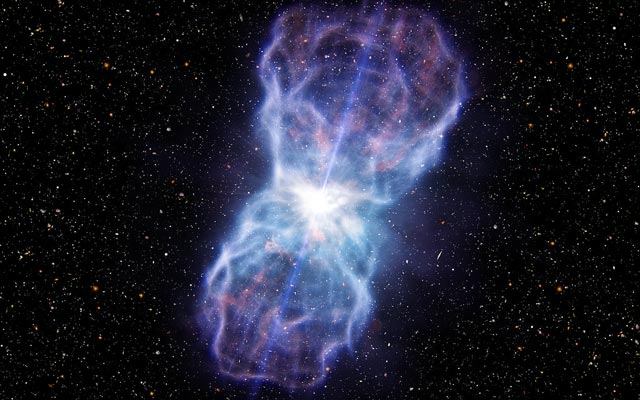
The quasar winds they and their team recently discovered weren’t just fast, but the fastest in the ultraviolet range: about 20 percent the speed of light (the equivalent of 200 million kilometers, or a Category 77 hurricane) and near a supermassive blackhole more than 10 billion light-years away. The discovery represents another piece of a galactic puzzle, and also opens hands-on learning opportunities for HSU students.
“Quasar outflows, and those at extreme speeds, have always fascinated me,” says Rodriguez Hidalgo. “Quasars might be a phase that some, if not all, massive galaxies go through, like adolescence. And we know quasars are there, but we are not sure how they interact with the galaxies around them. That’s why these extreme winds are so interesting.”
York University (Canada) Ph.D. student, Jesse Rogerson, led this research as part of this thesis. The team of researchers included Rodriguez Hidalgo, Penn State University and Erciyes University in Turkey. Their findings were published this month in the Monthly Notices of the Royal Astronomical Society.
Astronomers have known about the existence of quasar winds since the late 1960s. At least one in four quasars have them. Quasars are the disks of hot gas that form around supermassive black holes at the center of massive galaxies.
“As matter spirals toward a black hole, some of it is blown away by the heat and light of the quasar. These are the winds that we are detecting,” says York University Associate Professor Patrick Hall, who is Rogerson’s supervisor.
Barely larger than the Earth’s orbit around the sun and much hotter than the sun’s surface, quasars generate so much light and heat that they (unlike the hundreds of billions of stars in galaxies that surround quasars) can be seen across the observable universe.
Rogerson and his team used data from a large survey of the sky known as the Sloan Digital Sky Survey to identify new outflows from quasars. After spotting about 300 examples, they selected about 100 for further exploration, collecting data with the Gemini Observatory’s twin telescopes in Hawaii and Chile.
“We not only confirmed this fastest-ever ultraviolet wind, but also discovered a new wind in the same quasar moving more slowly, at only 140 million kilometers an hour,” says Hall. “We plan to keep watching this quasar to see what happens next.”
Much of this research is aimed at better understanding outflows from quasars and why they happen.
“We suspect that quasars and their host galaxies form and evolve together, and these winds might be the key connecting them,“ says Rodriguez Hidalgo. “From what we know, as big galaxies form, they should be making far more stars than what we actually observe. So something—maybe these winds—stops galaxies from producing too many stars.”
This research was supported by the National Science and Engineering Research Council of Canada, Government of Ontario, The Scientific and Technological Research Council of Turkey, and the National Science Foundation.
Through a $23,000 award from NASA and observing time with the Chandra satellite and Gemini North telescope, Rodriguez Hidalgo and her students will use the data to study how X-ray and UV quasar winds might be related.